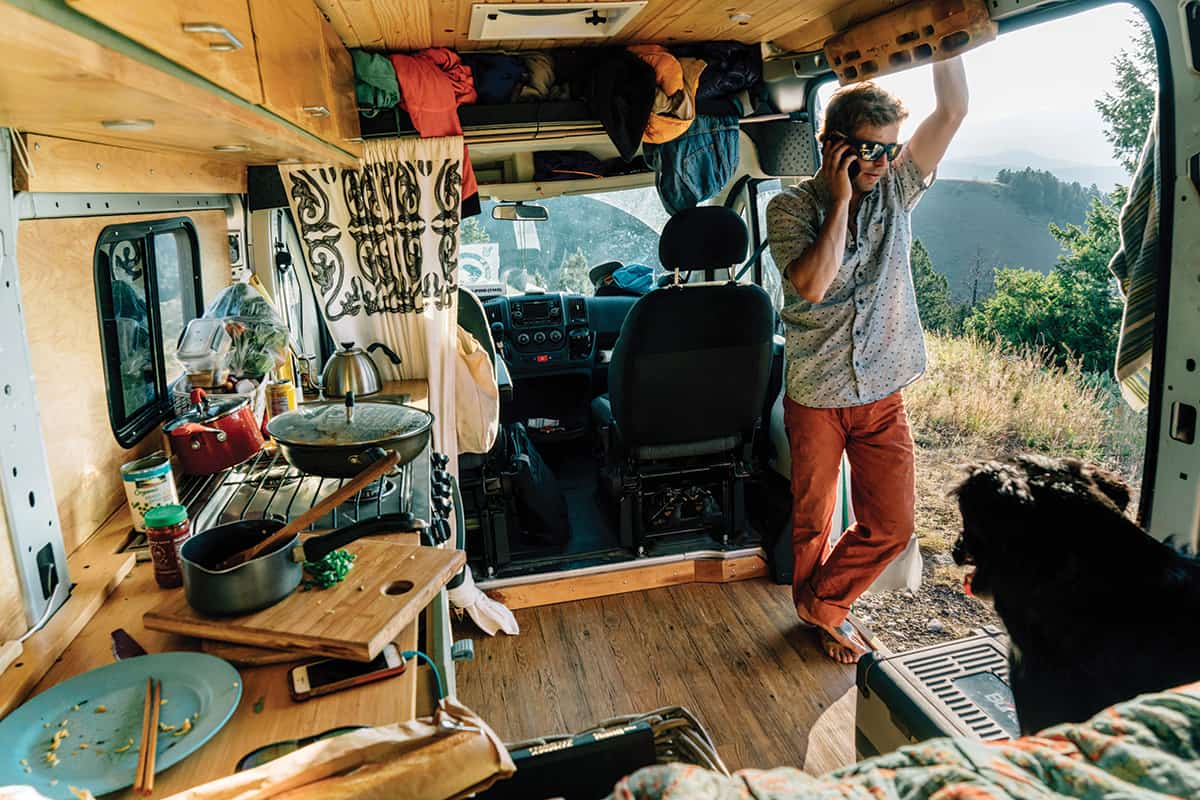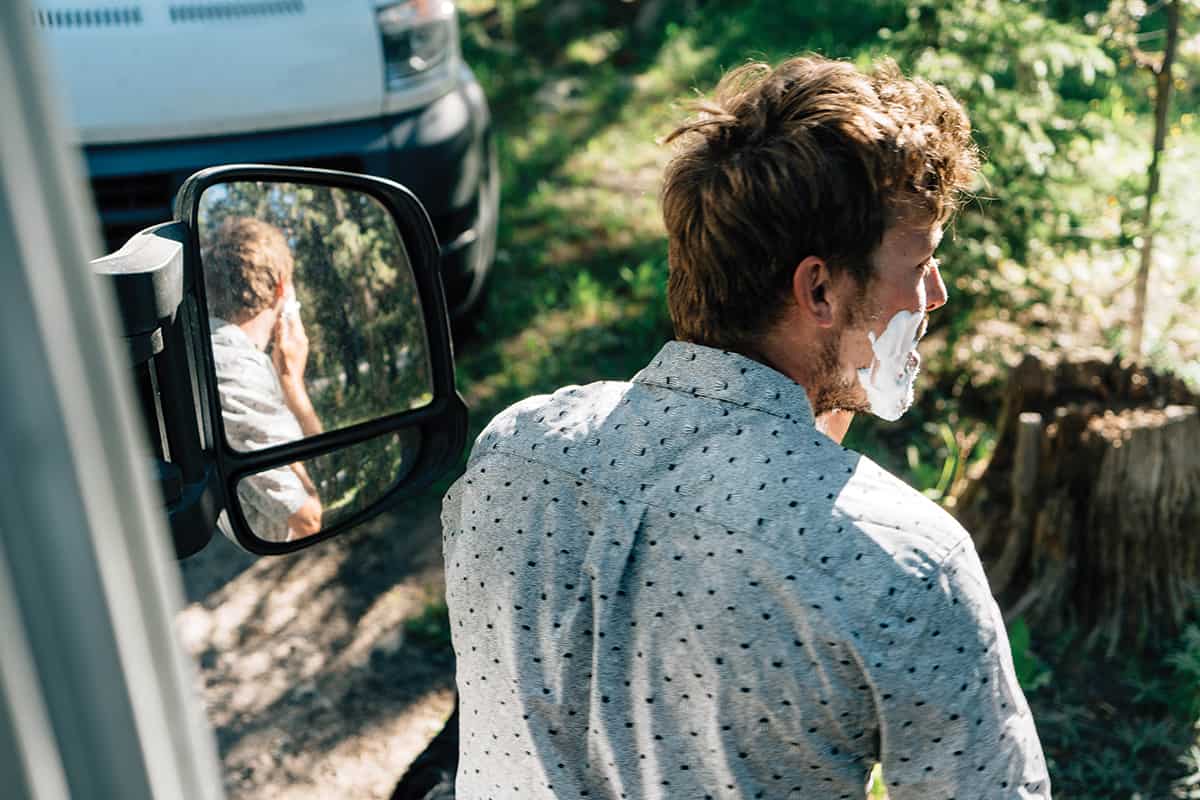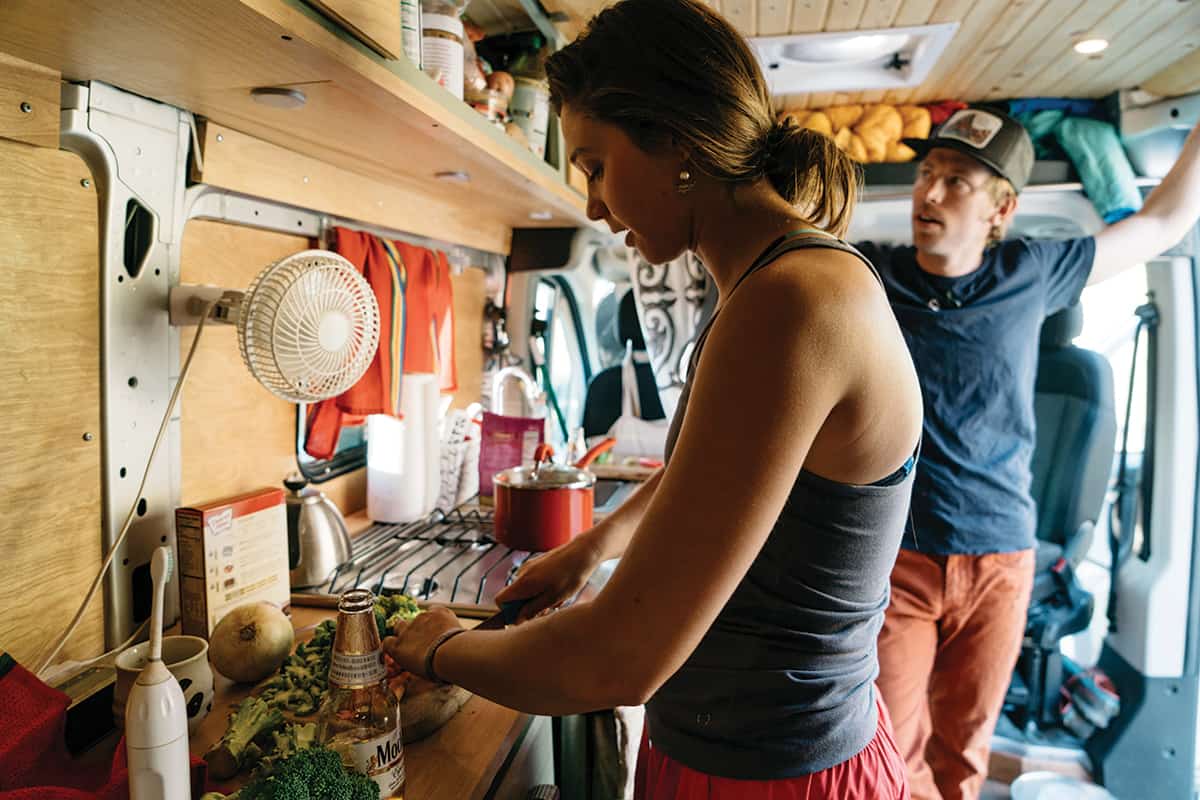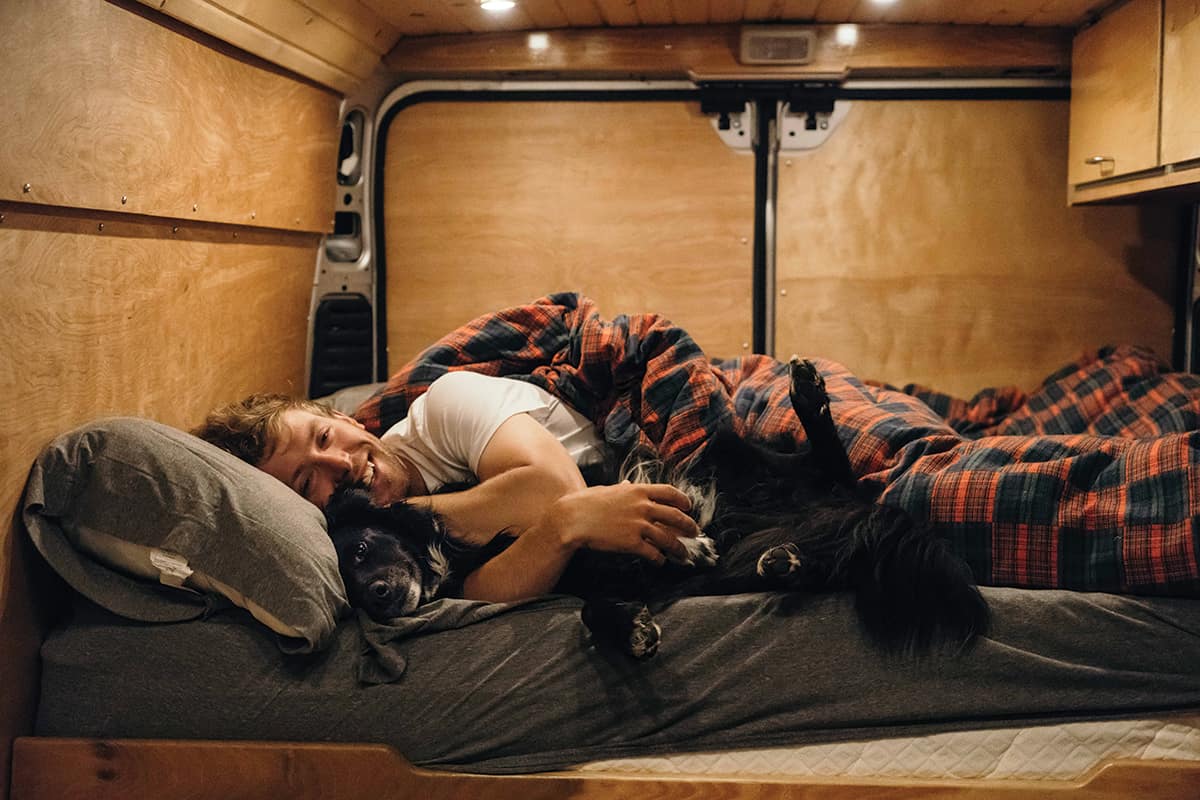Read The
Current Issue
Van Life
Whether out of choice or by necessity, some Jackson Hole residents call a van their home.
Story and photography By Leslie Hittmeier

EVERY MORNING I wake up to a new view. Sometimes it’s a friend’s driveway. Other times it’s a sidewalk, or a pine forest. This morning, since I woke in the dark, there wasn’t much of a view out our van’s window. But, as my husband, Ben, drives us back toward downtown Jackson and away from where we spent the night—the Sleeping Indian trailhead in the Gros Ventres—the sun rises and I catch a lone coyote sniffing his way across an empty National Elk Refuge. There are a lot of things about living in a van that suck, such as having nowhere to pee, no desk to work at, and nowhere to really live. But it’s moments like this that make up for all that. Watching the sun come up from our home on wheels with a hot cup of coffee in hand is pretty awesome.
Ben and I moved into our van at the beginning of summer 2017. For a lot of people, van life means being able to travel whenever they want, or it means the freedom to live anywhere. For us, it meant we could both do work we are passionate about while living in an expensive town. I wanted to quit my nine-to-five so I could start a production company with three other women. This was a dream opportunity, but one that wouldn’t be profitable for at least a year. Ben is an Exum Mountain Guide, a company that helps clients reach the tops of the tallest peaks in the Tetons, so it’s not like he could live anywhere but here. Rent prices in any neighborhood in Jackson Hole, and even in the Idaho satellite communities of Teton Valley and Swan Valley, are too high for two people living on one climbing guide’s wage. Moving into our van was a temporary solution. We hoped that if we lived in the van over the summer, we could 1) afford rent again by winter and 2) be able to find a place to rent.
IT’S NO SECRET that the town of Jackson has a housing crisis. The available housing—for rent and for purchase—is both expensive and scarce. Because of that, 47 percent of the workforce lives outside of Teton County, Wyoming. (The community first recognized a loss of local workforce housing as an issue in the early nineties, when the number of workers living outside the county was less than 15 percent.) According to the 2017 Jackson Hole Real Estate end-of-year report, the limited supply of houses and the high prices have accelerated to the point where most local potential buyers can no longer afford to even enter the market. David and Devon Viehman and Luke Smith, the report’s authors, don’t expect this will improve anytime soon. Instead they say, “This is the new normal.”
In 2017, the average price of a single-family home in Jackson Hole was $1.86 million. The average monthly rent price for a two-bedroom apartment was $1,800. And even those who can afford to pay that much in rent have a tough time finding a landlord to sign a lease and take their money. According to 2014 data, the most recent year for which figures are available, the rental market in Teton County has a vacancy rate of less than 1 percent.
When Ben and I moved to Jackson in June 2016, we knew it was an expensive place to live, but we didn’t appreciate just how expensive. According to AreaVibes, which assigns a “Livability Score” to communities across the country based on metrics including amenities, cost of living, crime rates, education, employment, housing, and weather, the cost of living in Jackson Hole is 44 percent above the national average.
IT WASN’T LONG after we first moved to the valley that Ben started talking about buying a van. I liked the idea but wasn’t convinced—I knew we’d have to live in it full time for multiple years to afford the expense. My parents offering to help us buy a car as a wedding present changed my mind. We decided on a Dodge Ram ProMaster because it’s the biggest van available that isn’t a $50,000 Mercedes Sprinter. In September 2016, we drove “Pam the Ram”—the most valuable thing we’ve ever owned—off the lot.
Businesses like Run Away Vans and Vanlife Customs will do anything from building out your entire van to making minor upgrades like custom cabinets or upholstery.
There are companies that exist solely to pimp out such vans. Businesses like Run Away Vans and Vanlife Customs will do anything from building out your entire van to making minor upgrades like custom cabinets or upholstery. There’s a legendary finish carpenter and artist named Scott Smith who works on vans in Mammoth, California. Under his company name, SmithMade Inc., he does advanced buildouts that involve things like installing teak wood floors and water filtration systems. Want to go really fancy? Smith can do a custom ceiling mosaic made of reclaimed wood.
Such enhancements were not in our budget, however, so we spent months making Pam livable ourselves. We installed solar panels and a fan and built a bed, storage, and a kitchen. The latter had an oven, gas stovetop, refrigerator, and sink. Ben wired electricity. We painted the cabinets olive green and repurposed climbing nuts as handles. The final touch was installing a hangboard, which climbers use to build finger strength, above the door. We didn’t do these upgrades thinking we were pimping out our summer home; rather, we thought they’d make Pam a sweet basecamp for climbing and skiing road trips.
But my monthly paychecks stopped in May. Ben and I and our dog, Cash, moved into Pam in June. With Ben immediately off to do guide training, my first day of van life was a disaster. My debit card got lost and I spilled essential oils—lemongrass and grapefruit—on Pam’s floor. I got no work done because I spent the day driving around, looking for a spot to park that was quiet and shady and also had strong cell service and fast Wi-Fi. My quest was unsuccessful. I didn’t want to go to the library or a coffee shop because it was hot and Cash couldn’t stay in the van. The day ended with me drinking a bottle of Vinho Verde and Pam parked for the night in a dirt pullout next to Akasha Yoga Studio in East Jackson. That night I slept horribly and woke up stressed. Maybe we’d made a mistake.
LIVING IN A van, or in any other vehicle, is illegal within Jackson’s city limits and on the public lands that surround town. People are permitted to camp for an allotted amount of time at U.S. Forest Service (USFS) campgrounds like Curtis Canyon—usually a maximum of fourteen days—and at privately owned ones like the Virginian RV Park in town. People can live in their van or in an RV if they are on private property and have permission to be there. Living in a van on Jackson’s streets is a big no-no, which I learned thanks to a very nice policewoman who kicked me out of Powderhorn Park for being there too long. Still, based on reports from Bridger-Teton National Forest (BTNF) patrollers, incident reports, and violation notices, it’s estimated that between three hundred and five hundred people lived in their vehicles around Jackson last summer.
“We believe residency is on the rise,” wrote Mary Cernicek, BTNF’s public affairs officer, in an email. “The predominant populations are summer transient employees who are unable or unwilling to find or pay for the limited housing opportunities available, but also include residents who rent their homes and live in campers, and persons unable to obtain legitimate housing due to legal issues.” She says counting can be difficult as these individuals change locations sporadically, have hidden hike-in camps, don’t occupy their camps until very late hours, and/or bounce between ranger districts or forests. Cernicek says that some are directed to camp in the national forest by their employers.
The day ended with me drinking a bottle of Vinho Verde, with Pam parked for the night in a dirt pullout next to Akasha Yoga Studio in East Jackson. That night I slept horribly and woke up stressed.
The BTNF has stay limits because long stays are tough on the land. When campers, whether in tents or vans, don’t move frequently, the land has little time to recover and regenerate. Plus, long stays create problems with human waste, trash, and campfires. “National Forest land managers are responsible for conservation and multiuse of the public lands, not housing,” Cernicek says. “And they are not equipped to keep up with demand and impacts of residency.”
Yet people continue to park their van-homes all over—on town streets, at undeveloped USFS campsites, at slightly more developed USFS campgrounds, in friends’ driveways, and even in “no overnight parking zones,” where they pull in late at night and leave early. During Ben’s and my summer of van living we met people doing all these things. There is an entire community of river guides who live in their vans and cars, some of whom can’t afford rent and others who can but don’t want to pay it. One day while “mobile officing” in the Home Ranch Welcome Center parking lot, I met Brendan Grady, a kayak guide for Rendezvous River Sports. As he chilled in his white 1992 Chevy Astro van waiting for friends before going out for an evening paddle, he told me the Snake River Canyon just south of Jackson is one of the most lucrative stretches of river for guides in the country; determined, personable guides can make five hundred dollars a day.
Last summer Sophie Danison, twenty-six, was not making five hundred dollars a day and did not plan on living in her car. She moved to the valley in July to work a contract editing job for Teton Gravity Research (TGR) and had a monthly housing budget of $800. She didn’t need anything fancy—a room in someone’s house would be fine. She started looking online and in local classifieds as soon as she arrived in town. She met with a few friends of friends who said they might have rooms opening up. Danison says she was told more times than she could count, “You’ll be the first one we call.”
Waiting for a call to come, Danison lived in the TGR parking lot in her silver Honda Element, “Lafonda the Honda.” With the rear seats removed, Lafonda had a little less than seventy-five square feet of cargo—a.k.a. living—space available. Danison built a bed frame where the rear seats had been. Her inflatable sleeping pad lived on top of the frame; underneath was storage. If she had to live in her car she wanted it to at least be cute, so she lined the inside of Lafonda’s back door with solar lights in the shape of pineapples. She didn’t find a place to rent until October.
THE HOUSING SHORTAGE and high prices impact local businesses. Hannah Koivu, the general manager of Healthy Being Café & Juicery in Jackson, lived in her Ford Transit cargo van with her boyfriend last summer. She estimates that a quarter to a half of the café’s summer staff was unable to find a place to rent last year. However, she says, “The crew last summer never had any issues finding camping in Curtis [Canyon] or Shadow [Mountain].” There are rumors that the BTNF will be cracking down on long-term camping this summer, though, and this concerns Koivu. “I honestly don’t know how we will be able to fill our staffing needs with the current housing crisis,” she says.
This past winter, Teton Youth and Family Services hired a new therapist for Red Top Meadows, a residential treatment and therapeutic wilderness program serving adolescent males. The nonprofit’s executive director, Bruce Burkland, says, “We have a great person lined up but she is having a difficult time finding somewhere to live.”
Joe Rice, the owner of Blue Collar Restaurant Group, which has Sidewinders, Merry Piglets, Noodle Kitchen, Bubbas BBQ, and Liberty Burger, saw this problem coming years ago and began taking steps to secure housing for his 250 employees. Blue Collar has helped staffers purchase their own places, bought and remodeled Raver’s Apartments and now rents and sells them to employees at below market price, and gives some employees rent subsides. “We take care of our people and know we are only as good as they are,” Rice says. “They are the key to our success, period.”
Local housing groups, employers, and the government are helping, too. Three years ago, the Teton County Housing Authority (TCHA) finished the first phase of The Grove: twenty affordable, deed-restricted rental apartments. Eighty-seven households, each of which could make no more than 120 percent of the county’s median income, applied for the available units. Critical service providers were given priority but having such a job or volunteer position was not a requirement. Rents are based on occupants’ salaries, and two-bedroom units range from $1,125 to $1,325, utilities included, per month.
This summer, another phase of The Grove will be finished: the first eight of twenty-four planned three-bedroom units built by Habitat for Humanity. Local families who make no more than 80 percent of the county’s median income and who have invested five hundred hours of sweat equity in helping build the units can apply to buy these. Also on track to be finished this summer are the Redmond Street Rentals, a partnership between the Jackson Hole Community Housing Trust, the Town of Jackson, and the Jackson/Teton County Affordable Housing Department. Like the first phase of The Grove, these twenty-six units are affordable, restricted, long-term rentals. And last November, St. John’s Medical Center finished construction on a twelve-unit complex of two-bedroom apartments for hospital employees These are rented at market rates—about $1,800 per month.
Last summer, the Jackson Town Council began the process of rezoning some residential neighborhoods with the goal of adding enough density to house 65 percent of the local workforce in town. The most density added will be south of town along the highway corridor.
There have also been some less traditional solutions tried: Last May, the Jackson Town Council approved an in-town municipal “campground” behind the Teton County Recreation Center. It was designed specifically for summer workers unable to find a brick-and-mortar rental and wanting to sleep in their cars.
No tents allowed. From June 16 to June 30, a space in the Rec Center parking lot was $225 per month. Despite low demand for this “off-season” price, in the high-season months of July and August rents more than doubled—to $465 per month. For their money, renters could park in designated spaces and had access to a porta-potty. Campers, who had to show proof they were employed in Teton County, could also use picnic tables in the nearby Home Ranch parking lot, but they had to buy monthly passes to the Rec Center to use its bathrooms with running water and showers. This project’s population peaked at nine occupied spots.
“The Rec Center was a very limited project,” says Jackson mayor Pete Muldoon, who lived in an old camper himself for three summers after he lost his home in the Great Recession. “But I think it worked well for what it was. It got some people out of the woods and sleeping in a safe place near where they worked. It’s not a substitute for a home, though.”
OVER THE SUMMER, Ben and I got better at van life, although it was always more challenging than life in a traditional home. Mundane things, like going to the bathroom, showering, doing laundry, and taking care of our dog required planning. But then there were the evenings when we did that cliché #vanlife thing—parked somewhere new and beautiful, opened the back doors, and lay in the bed drinking wine and watching the sunset. That’s not something that can be done in a traditional home. There were evenings when we cooked dinner while gazing at the Tetons. There were group campouts with car-dwelling friends.
We made tacos and played spike ball. Also, we did what we set out to do. We saved almost seven thousand dollars, which we used to move into a place with some roommates, one of whom is Danison. Ben and I aren’t opposed to moving back into our van, but for now we—and Danison—smile whenever we look out at our(!) driveway and see Lafonda and Pam sitting there empty, their purpose downgraded from mobile home to transportation. It’s also pretty nice no longer having to plan my life around figuring out where to pee.











